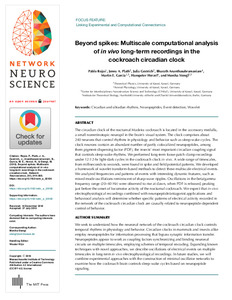| dc.date.accessioned | 2019-11-22T15:09:44Z | |
| dc.date.available | 2019-11-22T15:09:44Z | |
| dc.date.issued | 2019-09-23 | |
| dc.identifier | doi:10.17170/kobra-20191122807 | |
| dc.identifier.uri | http://hdl.handle.net/123456789/11365 | |
| dc.description.sponsorship | Gefördert durch den Publikationsfonds der Universität Kassel | ger |
| dc.language.iso | eng | eng |
| dc.rights | Urheberrechtlich geschützt | |
| dc.rights.uri | https://rightsstatements.org/page/InC/1.0/ | |
| dc.subject | circadian and ultradian rhythms | eng |
| dc.subject | neuropeptides | eng |
| dc.subject | event detection | eng |
| dc.subject | wavelet | eng |
| dc.subject.ddc | 570 | |
| dc.title | Beyond spikes: Multiscale computational analysis of in vivo long-term recordings in the cockroach circadian clock | eng |
| dc.type | Aufsatz | |
| dcterms.abstract | The circadian clock of the nocturnal Madeira cockroach is located in the accessory medulla, a small nonretinotopic neuropil in the brain’s visual system. The clock comprises about 240 neurons that control rhythms in physiology and behavior such as sleep-wake cycles. The clock neurons contain an abundant number of partly colocalized neuropeptides, among them pigment-dispersing factor (PDF), the insects’ most important circadian coupling signal that controls sleep-wake rhythms. We performed long-term loose-patch clamp recordings under 12:12-hr light-dark cycles in the cockroach clock in vivo. A wide range of timescales, from milliseconds to seconds, were found in spike and field potential patterns. We developed a framework of wavelet transform–based methods to detect these multiscale electrical events. We analyzed frequencies and patterns of events with interesting dynamic features, such as mixed-mode oscillations reminiscent of sharp-wave ripples. Oscillations in the beta/gamma frequency range (20–40 Hz) were observed to rise at dawn, when PDF is released, peaking just before the onset of locomotor activity of the nocturnal cockroach. We expect that in vivo electrophysiological recordings combined with neuropeptide/antagonist applications and behavioral analysis will determine whether specific patterns of electrical activity recorded in the network of the cockroach circadian clock are causally related to neuropeptide-dependent control of behavior. | eng |
| dcterms.accessRights | open access | |
| dcterms.creator | Rojas, Pablo | |
| dcterms.creator | Plath, Jenny A. | |
| dcterms.creator | Gestrich, Julia | |
| dcterms.creator | Ananthasubramaniam, Bharath | |
| dcterms.creator | Garcia, Martin E. | |
| dcterms.creator | Herzel, Hanspeter | |
| dcterms.creator | Stengl, Monika | |
| dc.relation.doi | doi:10.1162/netn_a_00106 | |
| dc.type.version | publishedVersion | |
| dcterms.source.identifier | ISSN 2472-1751 | |
| dcterms.source.issue | Issue 4 | |
| dcterms.source.journal | Network Neuroscience | eng |
| dcterms.source.pageinfo | 944-968 | |
| dcterms.source.volume | Volume 3 | |

